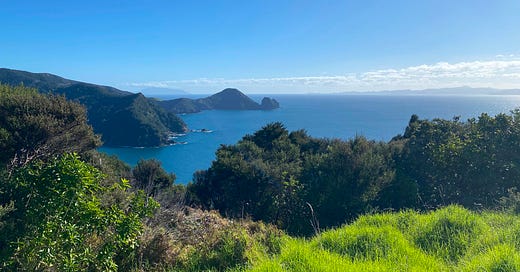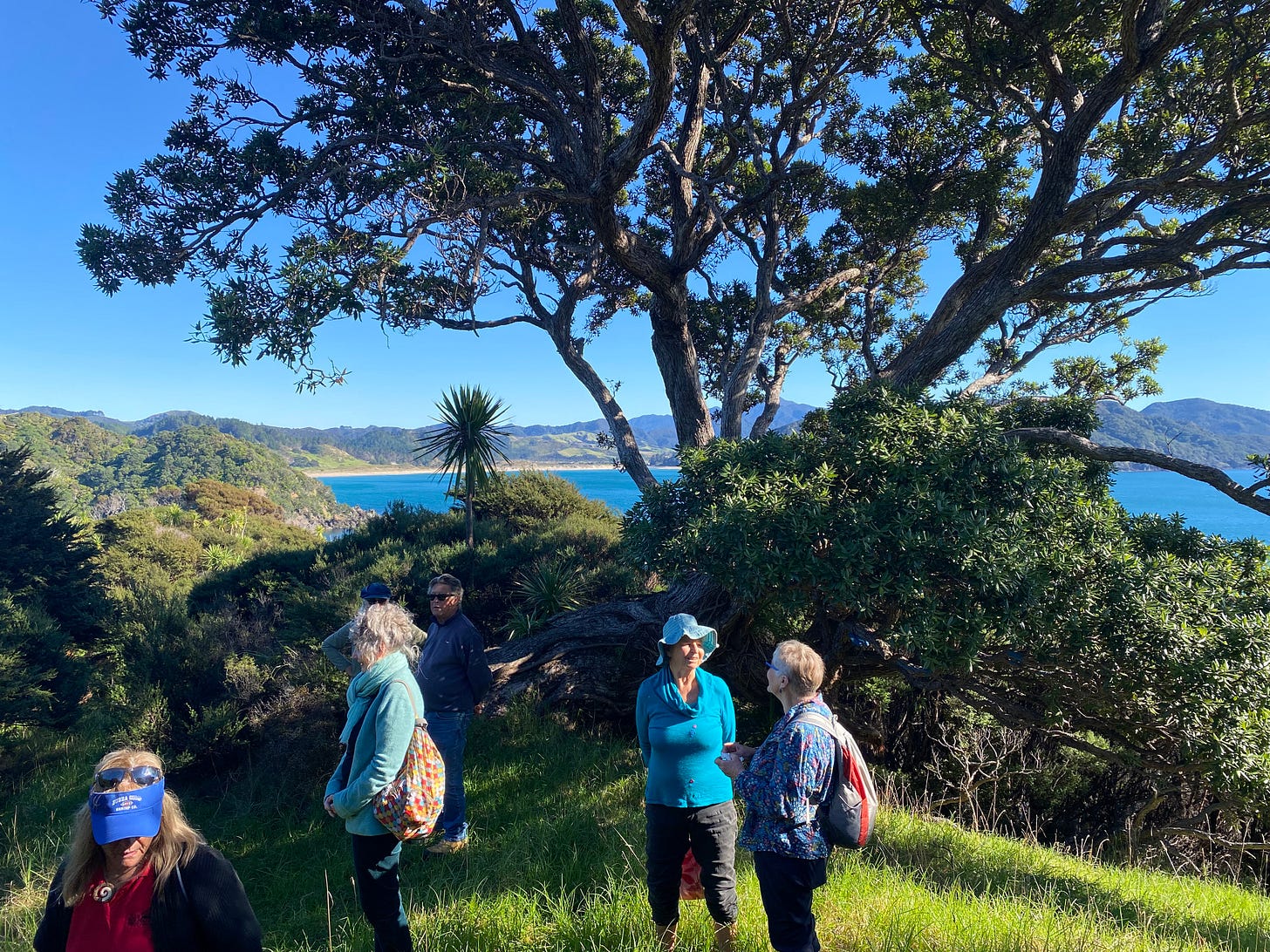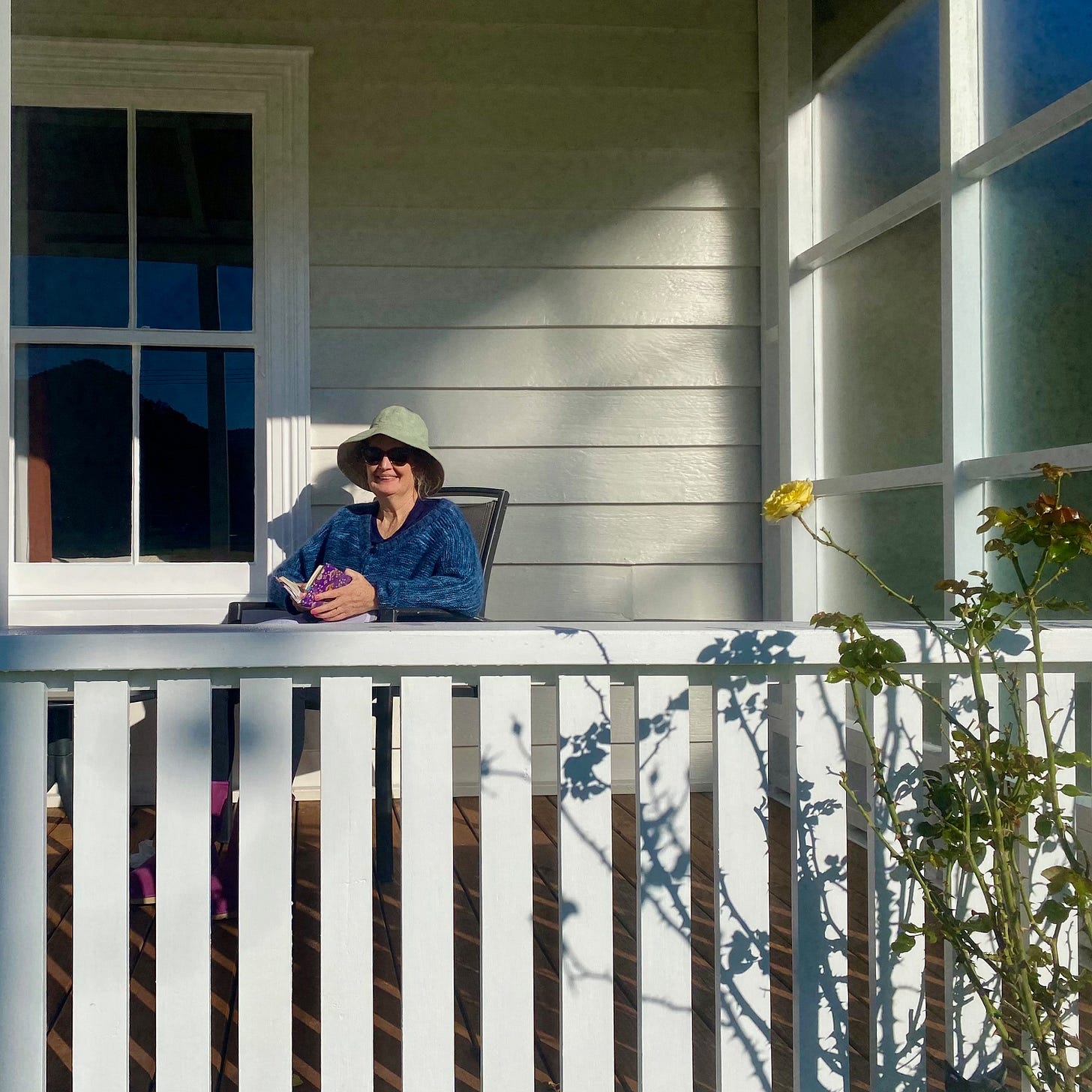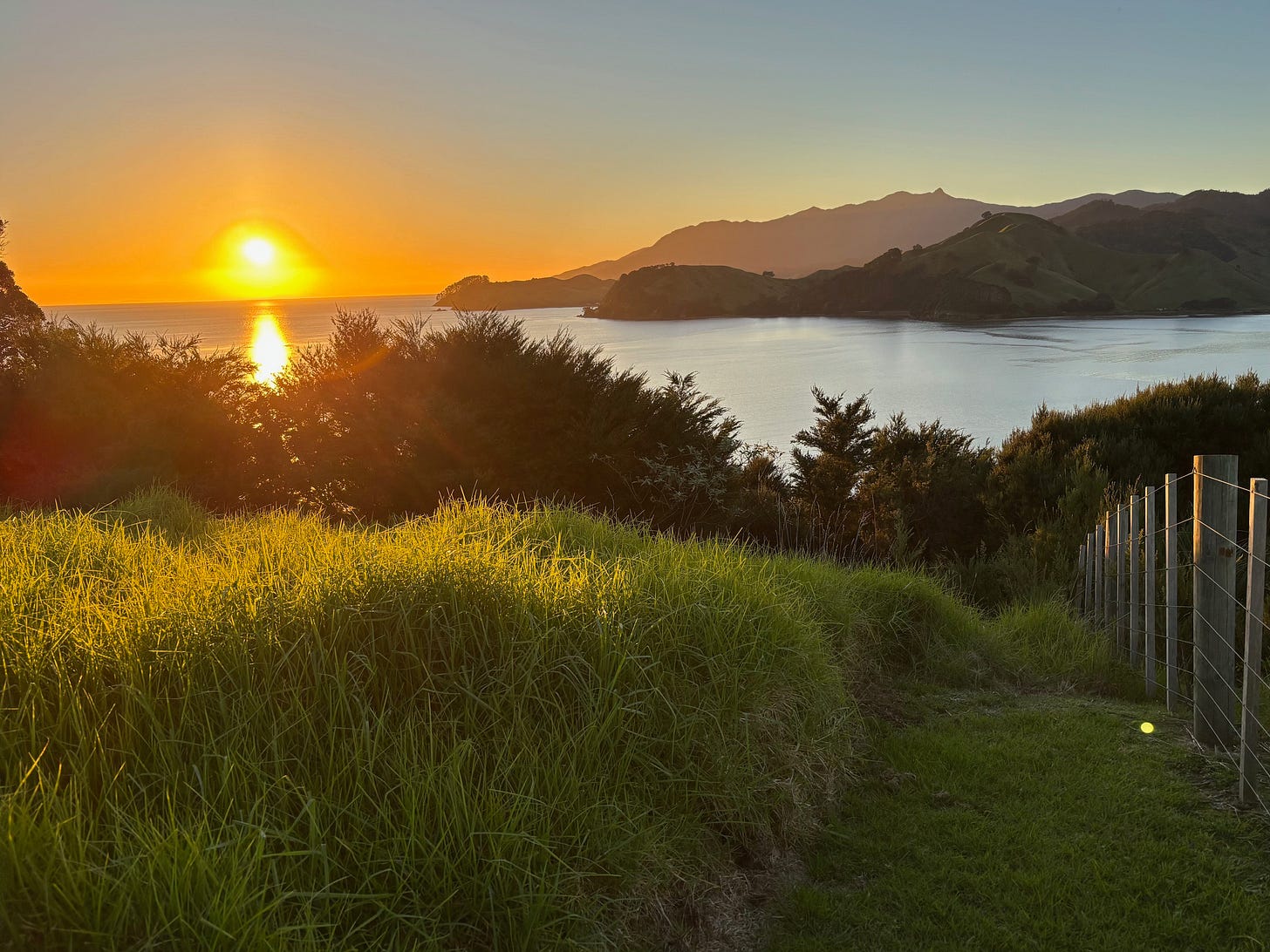Fifty shades of green
Notes from a writers’ retreat on the Coromandel peninsula in New Zealand
The moment I found out about the Coromandel Peninsula Writers’ Escape in New Zealand I was hooked. I have an affinity with peninsulas. The word ‘escape’ had something to do with the allure too. I imagined a remote location, with time out to write and be inspired by being with other writers, including any writerly friends I could cajole to come along … and then here we are. Me, Alan, Kerry, Simon, and Anna – all of us, apart from Dunedin boy, Alan, exiles from Sydney’s Northern Beaches peninsula …
On our first morning, the lovely Steph Parkyn, the New Zealand author leading the writing retreat meets us at Little Bay on the east coast of the Coromandel Peninsula. There are nine writers along for this first event, with more to join us in the following days. It is a beautiful autumn day, and the beach is deserted. Small waves are lapping the beach and further out to sea, the sun is creating silvery shimmers on the water.
Steph suggests we take off our shoes and socks and stand with our bare feet in the water. We shut our eyes and are prompted to become aware of all our senses. (Of course, my mind goes straight into panic mode, thinking we might soon be asked to describe our experiences.) The first impression that comes to mind is a feeling of being ‘fully alive’. The water is cool and tingly on my feet and the air I am breathing feels remarkably clean. Coromandel air has a spritz to it. Lighter somehow than the also very clean air we experience in Tasmania. I hear the sounds of the waves and the distant sing-song of birds.
Next, we walk to the end of the beach and cross a small stream; in the water a tiger’s eye pattern of light and dark colours. I wonder if this is caused by the heavier sedimentation of the raw-sienna-coloured soil we had noticed driving up the peninsula the day before. ‘Lots of clay in the soil up here,’ someone says.
Up the track beyond the beach, we marvel at the dense foliage – many trees and shrubs very different to our Australian flora. Steph identifies a native nikau palm tree, its foliage reminiscent of a feather duster, and ancient kauri and pohutukawa trees with giant ferns hovering high up in them – bunion-like formations known as widow makers because they sometimes fall off. She also points out the bushman’s toilet paper tree, rangiora, with its giant papery leaves. When I feel the leaves, it is easy to see it is called this. I also spot cabbage tree palms and banksia trees, but these are on a much larger scale than we have in Australia. I hear someone in the group talking about the ‘gigantism on islands’ theory of plant adaptation. We are in good company.
Further up the track, we begin the first of many of our conversations this week about how many different shades of green there are in the New Zealand bush. The Māori have many more words than we have in the English language to describe all the shades of green in New Zealand’s native vegetation. How will I describe them? I can’t remember the names of all the acrylic and oil paint tubes in the studio at my art classes but they could be useful for descriptive names of all the shades of green. Or would that be cheating?
We drive back to our cottage in Colville, the last settlement on the northern peninsula that has a café and a small general store with a petrol bowser. On the way, I notice the medley of dark and light greens in the hills and gorges we pass, everything from dark forest greens through to emerald and lime greens — and among them, the introduced gone-wild interloper, pampas grass with its feathery cream-coloured flower heads. It’s also along the side of roads, catching the sun and bending like joyful wind flags as we whoosh by.
Back at the cottage, I decide to choose a card from my I Ching pack. Usually, I pose questions and throw the coins to get an answer but this time I look through the cards and look for one that best describes my day and my intentions for being here, in this country of my birth.
I decide that 25. Innocence/Disentangling seems the most appropriate.
Above: Chien. Creative, Active, Heaven.
Below: Chen. Thunder, Movement.
Interpretation: Learning to be a guest, to observe more and react less. Compassion. Openness.
Already the Coromandel peninsula feels like heaven. I’m excited. I like to think that this writing retreat will be about learning to be more observant to enhance my creativity. As we sit at the dining room table to pour glasses of wine, to talk and laugh about our day I acknowledge that it is going to be about friendship and making memories too.
On Wednesday we immerse ourselves in nature again. We spend a full day, in a ‘Hike and Bike Coromandel’ bus, going up to the northernmost end of the peninsula. First stop is a kiwi interpretation platform where we learn that the northern Coromandel is home to the largest predator-controlled kiwi habitat on the New Zealand mainland with almost 30,000 hectares of stoat trapping being undertaken by the local Moehau Environment Group. Steph plays recordings of the male and female kiwi. We laugh that the females have a much more aggressive call than the males.
Two of the women on the bus, Robyn and Sue are part of the volunteer crew who lay the stout traps. Both are also St John’s ambulance volunteers and volunteer firefighters. Our Hike and Bike Coromandel host and bus driver, Gavin, tells us that the Northern Coromandel area tops New Zealand for its ratio of volunteers per head of population. It’s a sparsely populated but very close-knit community.
Onwards, we pass many bays and tiny settlements and learn about the history of the area and the remote communes that once flourished here. We hear stories of local characters – and drug barons. At Stony Bay, the end of the road, we spend a couple of idyllic hours either walking the start of the 10 km Coromandel Coastal Walkway, communing with the very old pohutukawa trees (one here is estimated to be over a thousand years old) or just generally taking in the awe-inspiring scenery. I am impressed by how pristine the environment is. There is very little rubbish to be seen.
By Thursday, apart from jotting a few notes, I haven’t done any writing. I know that over the next two days, we will have time for writing. I’m slightly hampered by the fact that I haven’t brought a computer along so have to cadge computer time off Anna, Kerry, and Alan. We get to know the local Colville area with walks to the cemetery, to Hereford ‘n’ a pickle for a coffee, along the waterfront, and up the hill above our accommodation for sunset viewing.
On Friday we are invited to write together in the Colville Café building. Simon, Anna, and I escape in the afternoon for a drive to Coromandel Town for some shopping. We pick up locally ‘cold’ smoked salmon for Anna’s creamy pasta dish. Saturday is a full day of writing workshops led by Steph. As a group of writers, we cover many genres. Two of us are memoir writers, three poets (including Alan, whose debut poem is a knockout), two fiction novelists (one writing historical fiction and the other YA dystopian novels), one scriptwriter, two short story writers, plus three general non-fiction writers.
The morning’s session is ‘Weaving Ideas into Story’ and among other topics is about how to give our writing the narrative drive to keep readers engaged. We are given many suggestions. The afternoon’s session is an editing workshop and once again Steph has lots of tips and tricks to share. We are all on a high following the sessions. A concert that night in the local hall by New Zealand country singer-songwriter, Donna Dean, is a further highlight for many of the writers – not me though, I am too pooped.
The following day, our last full day on the ‘escape’, we share lunch at Steph and her partner Paul’s hilltop home overlooking Little Bay and beyond. By then we are all very comfortable with one another and it is a time for sharing contact details and reflecting on what we’ve gained from the week. For me, the ‘escape’ was everything I had hoped for and more. Although I didn’t get a great deal of writing done I was inspired by the workshops and all the conversations about writing that took place during the week. I learned the value of observing and engaging the senses first before hitting the keyboard. Steph’s warm and generous personality, writing skills, and infectious laugh made our guided sessions both informative and fun. I also enjoyed our immersion in such a magical place and community, and the rare and wonderful opportunity to spend time together with long-time friends.
Thanks to Stephanie Parkyn; Gavin and Leanne from Hike and Bike Coromandel; Sherrie from Wai Wurri Cottage, Colville; and John, Kerry, and Zach Macaskill-Smith for the loan of the car and the wonderful hospitality at both ends of our ‘escape’.








Wonderful words. I have enjoyed sharing your excitement and enjoyment during this experience. A perfect escape x
Such a vivid account of our very special time on the retreat Lee. I loved reliving all those moments. It was wonderful sharing this with you and the others. Thank you for leading the way